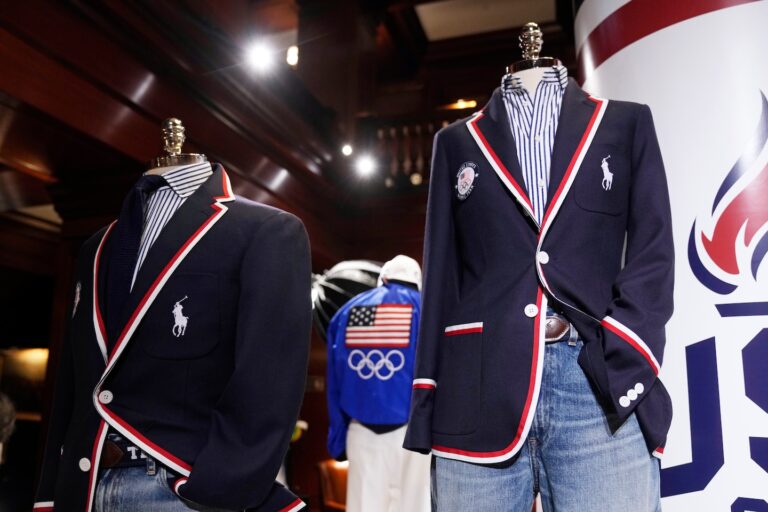A news release called it a “very modern interpretation of the tailored look,” and the company even set up an atelier in Paris to outfit the 1,500 athletes to their liking. But while the jeans are loose-fitting and slightly cropped for a stylish look, in reality the outfits look rather dated, too similar to the silhouettes (snug jeans, even snug blazers) that flooded J. Crew stores during its menswear heyday more than a decade ago. That the athletes are wearing these clothes with a staple of American menswear almost of the past, white bucks, only underscores the connection.
For preppy style to work in 2024, it needs to have a wink — that is, without looking like you’re serving ice cream at an overpriced hipster ice cream parlour on Nantucket or the mayor from “Jaws.” It needs details that show the wearer is in control of a bit of bold style, like a funky tie, unexpected shoes, loose shoulders that make the outfit feel a bit more casual, or, as in the case of Thom Browne’s similarly striped, shrunken suit, an eccentric fit.
But there are winners. The Closing Ceremony uniforms are a lot more fun: moto-style jackets decorated with patches and lara lettering (“TEAM” on one blue epaulette, “USA” on the other red epaulette) that the athletes will wear with white jeans and polo shirts.
Sarah Hirshland, CEO of the United States Olympic & Paralympic Committee, said in a statement that the design “not only captures the essence of American style, but embodies the spirit and pride of Team USA.”
Do they really capture the essence of American style? I’m not sure.
Ralph Lauren’s greatest contribution to fashion history was his innate and highly creative understanding that in America, it is not fashion but style that creates meaning through clothing. He managed to transform the conformist nature of the medium into a celebration of individuality, taking his cues from the eccentricities of American aristocracy and turning them into an aspirational adventure through a playful, cinematic sieve.
Lauren’s point rings true: The most stylish people in American history, from Nan Kempner to Michelle Obama to Rihanna, have never bowed to the whims of a designer. They take (or don’t take) ideas from the runway, the mall, or someone they pass on the street, and turn them into something expressive and uniquely their own. That, more than any designer or style, defines what clothing means in America, and what the idea of America stands for. Whatever your political stance, the uniform seems too conservative.
Others in the kit stand out. In contrast, we see the players wearing an assortment of Villagewear, a selection of clothing designed to be worn between matches, also provided by Ralph Lauren for the team’s players. Look at volleyball player Chiaka Ogbogu in loose white trousers and a cinched-in cotton safari-style jacket, or Paralympian Melissa Stockwell in a cropped rugby shirt, striped button-up and white cotton shorts. There’s no better way to say it than to use a cliché: they are the ones wearing it, not the other way around.
To see the American sprezzatura even more clearly, look at the way professional and amateur athletes have completely rewritten the style rulebook of the sports world. NBA and WNBA players have taken pregame dressing as an opportunity to boost their own fame and the profile of their sport, and many of them dress better than almost any other celebrity in film, television, or music. (A recent photo of Skylar Diggins-Smith in a white button-up shirt and black leather skirt is more instructive than any fashion magazine recommendation for looking stylish and powerful.) Many brands, including Tory Burch and Norma Kamali, have made sportswear an important part of their offerings, recognizing that even those of us who don’t get paid to exercise sometimes aspire to look like those who do.
Clothing will take a much more central role in this year’s Olympics than in past ones, because the games are being held in a city that is the fashion capital of the world, at least in terms of luxury revenue.
The problem may be that the concept of patriotic dress is now too complicated: at a time when Americans are so conflicted about the direction of their country, it’s nearly impossible to tuck the flag onto a shirt without offending someone. (In any case, the look is better than the even tighter blue blazer and jeans expected at the 2021 Tokyo Summer Olympics.) The First Lady, for example, recently adopted an almost entirely blue uniform, as if to establish herself as a symbol of stability, rather than the overtly bipartisan or patriotism of red, white, and blue.
It’s fitting, then, that the official uniforms for this year’s opening ceremony are coincidentally appropriate: outdated, struggling to define itself, a reminder that American dress is the least of our problems.

